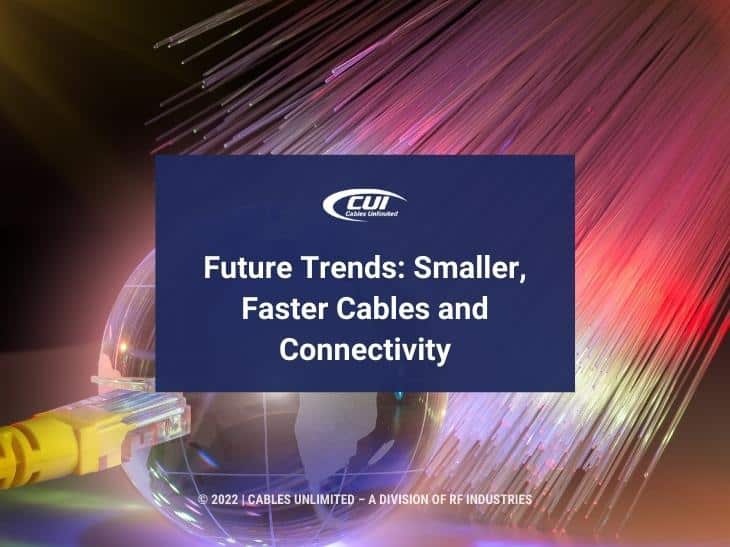In the world of technology, the never-ending drive is to achieve more with less. For cables and connectivity, that boils down to moving signals faster and doing so in a smaller space. Those are the two main drivers of future trends, smaller, faster fiber optic cables, and connectivity. Supporting that effort are also improved materials both for conductors and insulators, along with bringing all of that together into customized cables to simplify installation.
This article briefly addresses all those factors and provides a few examples of the improvements underway that we can expect to see more of in the future.
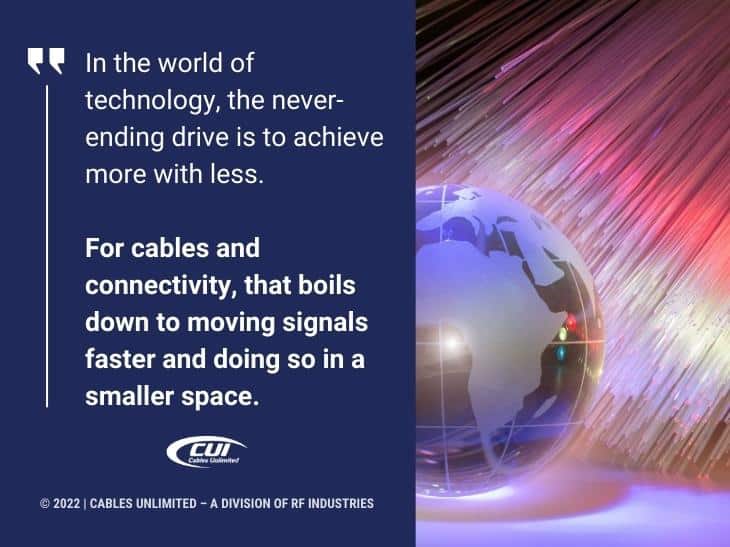
Faster Speed
We spoke about higher speeds in Fiber Optics in the Future, It Only Gets Faster. As recently as 2007, the top broadband speed was 16 Mbps. Ten years later, in 2017, the maximum speed was 2,000 Mbps or 2 Gbps. Right now, 88% of U.S. homes have access to 1 Gbps, and Google has one cable with a speed of 60 Tbps.
The same drive for speed is also found in shielded twisted-pair Ethernet cables. Cat5 supports 100 Mbps, Cat6 reaches 1,000 Mbps, Cat7 specifies 10,000 Mbps, and Cat8 is specified to provide 25 Gbps and even 40 Gbps.
Then there’s HDMI 2.0, also known as Ultra High-Speed HDMI cable. It delivers resolutions up to 10K and dynamic HDR formats with a data transfer rate of 18 Gbps. This is up from 10 Gbps for HDMI 1.4.
Whatever the cable type, from optical to copper, increasing speeds are required to meet current and future demands. That takes a cable manufacturer that can keep up with the advancing technology and manufacture cables with the highest standards.
Read more in our blog: Fiber to the Home (FTTH) Growth – How and Why Insight
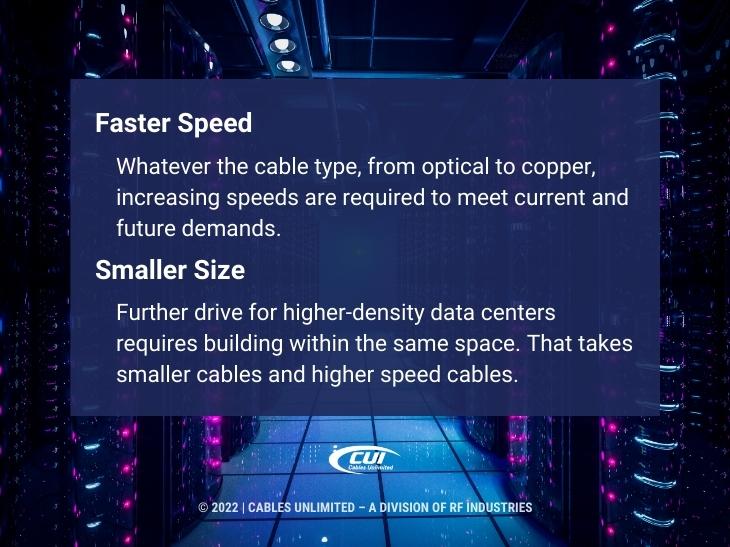
Smaller Size
From cables to connectors, the growing demand is for smaller sizes to meet the needs for increased miniaturization of products and high-density installations. For the former, think of the Internet of Things and the ever-increasing demand for automation. Now your refrigerator advises you what to pick up on the way home from work. That takes cables and connectors to match sensors with processors and transmit the latest data over the Internet. All that must be done in the same footprint as the old refrigerator.
There is a further drive for higher-density data centers. It’s called doing more with less. That requires building a faster and higher-capacity data center within the same space and doing so without shutting down the existing center. That takes smaller cables and higher-speed cables. This is where high-density multi-mode fiber optic cables can provide higher speeds and more data streams over the same fiber.
In the telecommunication industry, 5G and soon-to-arrive 6G are using small cells installed on light poles and traffic lights to bring high-speed cellular service to every square inch of urban areas. That calls for much smaller footprints with 5 to 10 times more small cells replacing or supplementing traditional macro cells. As a particularly vivid example, that requires smaller cables and equipment to fit in a container the size of a pizza box.
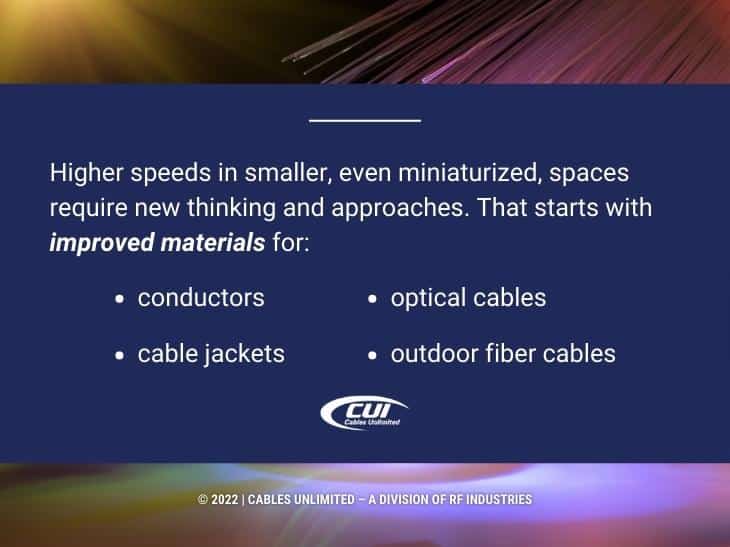
Improved Materials
Higher speeds in smaller, even miniaturized, spaces require new thinking and approaches. That starts with materials for conductors, including copper magnesium, copper tin, copper silver, copper-clad steel, and brass.
It doesn’t stop with cable conductors as it extends into materials for cable jackets that increase flexibility, durability, and longevity when exposed to UV radiation and other hazards. These materials also increase safety, including low-smoke or zero-halogen (LSZH) materials. Low-smoke materials reduce smoke during fires and improve visibility when extinguishing the fire. Zero-halogen prevents toxic gases when burned.
There are further improvements underway for optical cables. Plastic optical fibers with increased bandwidths to 3 GHz per 100 meters, low loss to 1,550 nm, and higher power handling capabilities are currently in development. This offers a lower cost than glass fiber and could replace copper in some applications.
There are also improvements underway for outdoor fiber cables, from direct burial to underwater applications. See our article Choosing the Right Outdoor Fiber Cable.
Customized Fiber Optic Cables
Faster and smaller cables and improved materials come together to fit specific installations via customized cables. That means cable assemblies and hybrid cables combine all the cables needed for a particular installation, from copper to coax to fiber. And it’s not only signal cables, but also remote line power included in the assembly. Incorporated in a single jacket, cable assemblies, and hybrid cables greatly simplify installation, reduce labor costs, and eliminate troubleshooting for miswired individual wires.
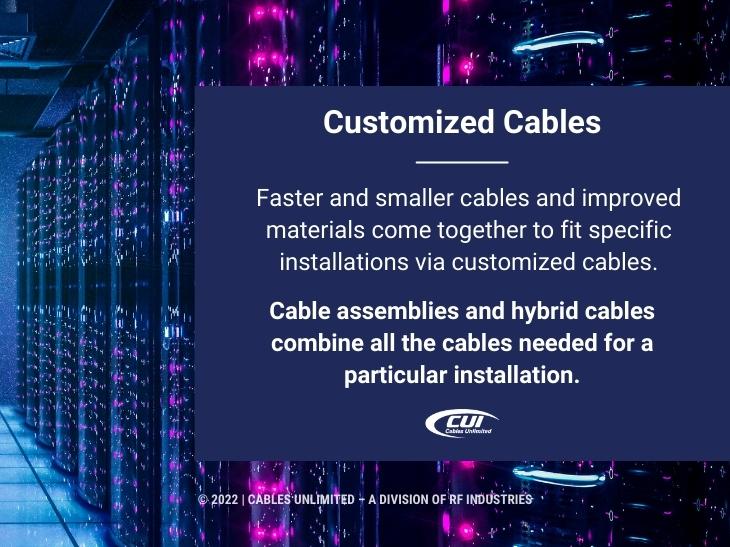
We Can Help with Your Fiber Optic Cables Selection
Nearly all the future trends with cables and connectivity are here right now to one degree or another. You’ll find that we’re perfectly positioned to provide precisely the right fiber optic cables for your project.
If your requirements are already specified and ready for a quote for your current projects, we are prepared to meet your deadlines and pricing targets. Our extensive in-house services and advanced manufacturing capabilities are in place to meet your requirements.
But Cables-Unlimited offers much more than state-of-the-art manufacturing – our dedicated team is also known for going to great lengths to meet the needs of our customers, including working round-the-clock to meet tight turnaround time requirements.
Our sales representatives are standing by to assist you with product questions and quotes Monday – Friday, 8:00 am to 5:00 pm Eastern. You can also send us an email or complete our contact form, and we’ll get right back to you.

